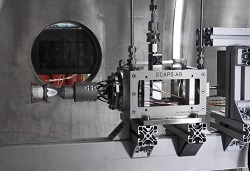3D catalysts for improved hydrazine-free propellants
Hydrazine is highly toxic, corrosive, and carcinogenic to living organisms. In 2011, the European Commission included hydrazine amongst the candidates for the list of substances of very high concern, which is regulated by the Registration of Evaluation Authorisation and Restriction of Chemicals (REACH) framework. Since then, universities, research institutes and industries all over Europe have been actively exploring and testing non-toxic propellants as a possible replacement for hydrazine-based propellants. One of the projects that have focused on alternative propellants for space propulsion systems was the Rheform project. Funded by the EU, researchers worked on improving propellants based on ammonium dinitramide (ADN). Replacing hydrazine with new propellants will make space propulsion more sustainable for future missions. Overcoming current challenges Although alternative propellants possess characteristics that make them highly desirable for use in launcher and spacecraft, these benefits come with constraints. The combustion temperature of LMP-103S – a blend of ADN, water, methanol and ammonia – is 1600 °C, much higher than that of hydrazine, which is about 900 °C. To withstand such temperatures, combustion chambers utilise special materials that comply with certain criteria of the International Traffic in Arms Regulations (ITAR) in the United States. Another big problem is that the catalyst used to decompose and ignite the alternative propellant needs to be heated before ignition. The catalyst is currently electrically pre-heated to a temperature of about 350°C, which takes around 30 min before firing, to ensure decomposition of the propellant. Such long pre-ignition time is problematic in emergency situation, where a prompt ignition is required. “The Rheform team has therefore focused on synthesising catalysts that require lower temperatures for pre-heating and adapting the currently existing ADN-based propellants so that the materials used in the combustion chamber are compatible with existing materials available in Europe,” points out Dr Michele Negri. To achieve this goal, development activities were conducted both on catalyst development and catalytic ignition. Feasibility of lowering ignition temperature The researchers’ goal was to build a decomposition chamber for the propellant that is capable of ‘cold start’. Soon enough, after testing 40 different catalysts in a batch reactor, the team realised that the water content of the propellants had to be vaporised before coming into contact with the ignition source. The vaporisation was achieved by placing a heat bed at the entrance of the combustion chamber. Some of the catalysts had ignition temperatures just above 100°C. As Dr Negri states, “The plan of developing a catalytic system capable of a completely cold-start was not deemed feasible.” Stronger catalysts with 3D printing Researchers have explored two different kinds of catalysts: catalyst pellets made from large grains and monolithic structures patterned with internal channels that allow the propellant to flow. Monolith structures are built from ceramic materials. The project team performed several simulations to properly understand the impact of material properties on the catalyst structure performance to ultimately build an efficient decomposition chamber. Amongst the several types of ceramics tested, researchers selected hexaaluminate structures for their excellent resistance to high temperatures and thermal shocks. Another novelty introduced by Rheform is 3D printing of these ceramic structures. 3D printing allowed them to produce monoliths with a very complex geometry. “This is the first time that 3D-printed ceramics such as hexaaluminate structures are used for propellants,” states Dr Negri. The true potential of alternative propellants Both European and American space agencies have rated green propellants for propulsion systems as a high-priority technology. The main goal of Rheform was to improve performance, reduce costs and minimise exposure to harmful substances with new environmentally friendly liquid propellants. As Dr Negri explains, “One of the big advantages of propellants alternative to hydrazine is that they are safer, while also decreasing the complexity and cost of testing, shipping, handling and launching.” Altogether, 13 SkySat satellites were launched from 4 different locations which clearly demonstrates that such hydrazine-free propellants allow operational flexibility and permit the launch of spacecraft from different sites.
Keywords
Rheform, propellants, catalysts, hydrazine, ammonium dinitramide (ADN), 3D printing, space propulsion, ceramic structure







